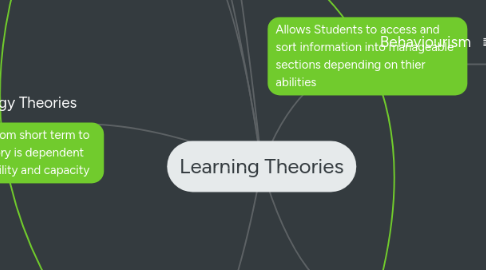
1. Cognitivism
1.1. Atkinson-Shiffrin Memory Model
1.1.1. Sensory Memory
1.1.2. Short Term Memory
1.1.3. Long Term Memory
1.2. Working memory has replaced short term memory: Students will learn better through doing, and memorizing, the individual steps, cementing the information into long term memory.
1.2.1. Scaffolding: Providing supports that are gradually lessened as the student gains mastery of the task.
1.2.2. Schema: building on what the student already knows to teach them the whole conncept.
1.3. In Teaching: scaffolding definitely has its benefits, however, it does not take into account students who do not need to be scaffolded to complete a task. Students who have mastered the task without the scaffolding become students who are left behind in the class because they need to wait for the scaffolding of the other students to take place. If all students are participating in the scaffolding you have the same problem of students who master each task quickly become bored with class and lose motivation.
2. Technology Theories
2.1. SCOT
2.1.1. Key Theorists: Bijker and Pinch
2.1.2. Social Construction of technology: Society and human action influence technology
2.1.3. Technologies are created where there is a need. i.e. cell phones and laptops for portable convenience.
2.2. Media Ecology
2.2.1. Key Theorists: Postman and McLuhan
2.2.2. Technology is an influence and society and we are all subjects of the digital era.
3. Cognitive Load
3.1. Processing information can over or under load working memory.
3.2. Working memory is different for every person and it is therefore difficult to measure understanding and higher order thinking skills. The key is to achieve a balance that will benefit all students, those who have more working memory than other and those who have less, providing different resources and tasks.
4. TPACK
4.1. Technological Knowledge: Knowledge of technology and its uses.
4.1.1. + Content Knowledge = Technological Content Knowledge (TCK) + Pedagogical Knowledge = Technological Pedagogical Knowledge (TPK)
4.2. Content Knowledge: Knowledge of your subject area.
4.2.1. + Pedagogical Knowledge = Pedagogical Content Knowledge (PCK) + Technological Knowledge = Technological Content Knowledge (TCK)
4.3. Pedagogical Knowledge: Knowledge of how to teach.
4.3.1. + Content Knowledge = Pedagogical Content Knowledge (PCK) + Technological Knowledge = Technological Pedagogical Knowledge (TPK)
5. Philosophy of Teachnology
5.1. A individual teacher’s view of how to incorporate technology into his or her teaching and learning process. Dependent on the teachers comfort level with technology, their school resources, and their subject area.
6. Behaviourism
6.1. Classic Conditioning - Pavlov
6.2. Stimulus Response (Repetition)
6.3. Operant Conditioning (Reinforcement)
6.4. Rewards and Punishments. Consequences for actions
6.5. Teacher directed learning environment. Direct lecture instruction
6.6. Practices: Modeling, shaping, cuing, drilling, and practice
6.7. Criticism: Learning is not always tied to behaviours, learning does not require rewards or punishments; does not allow for intrinsic motivations for learning.
6.8. In Teaching: behaviours are too complicated to be controlled in the classroom environment, this, along with considerations for culture and classroom management, makes behaviourism, on it’s own, a theory which must be used sparingly.
7. Connectivism
7.1. Key Theorists: George Siemens and Stephen Downes, 2006
7.1.1. Situational Analysis / Drivers
7.1.1.1. What is driving us to do this?
7.1.1.2. SWOT Analysis
7.1.1.2.1. Strengths
7.1.1.2.2. Weaknesses
7.1.1.2.3. Opportunities
7.1.1.2.4. Threats
7.1.1.3. Customer Findings - What have we learned from customers?
7.1.2. Competitive Analysis
7.1.2.1. Do we have competitors and threats in these target markets with the proposed offerings?
7.1.2.2. What are our competitors doing and how are they positioning?
7.1.2.3. How do we position against each competitor?
7.1.3. Target Customer(s)
7.1.3.1. Buyer Profile
7.1.3.1.1. Title
7.1.3.1.2. Industry
7.1.3.1.3. Geography
7.1.3.1.4. Business Size
7.1.3.2. Influencer Profile
7.1.3.3. User Profile
7.1.3.4. What do customers want and need?
7.1.3.5. What business problems do each of these customers have?
7.1.4. Customer Segmentation
7.1.4.1. Which customers or sets of customers do we sell to?
7.1.4.2. What are the target market segments that we want to go after?
7.1.4.3. What are the distinct problems for each segment of the market?
7.1.5. Total Available Market
7.1.5.1. New Prospects
7.1.5.1.1. How much of each target segment have we penetrated?
7.1.5.1.2. How much opportunity is available in each target segment?
7.1.5.2. Existing Customers
7.1.5.2.1. Can we up-sell existing customers?
7.2. Focus on informal vs. Formal learning. MOOC, massive open online course in which students search for information rather than having information given to them by the instructor.
7.2.1. Service Offer
7.2.1.1. What are we selling?
7.2.1.2. Product Definition
7.2.1.3. Pricing
7.2.1.4. Packaging
7.2.1.5. Positioning
7.2.2. Value Proposition
7.2.2.1. What is the Value Proposition to the Customer?
7.2.2.2. What pain are we solving?
7.3. In Teaching: This where education is invariably headed. With the 21st century learner, technology is at the forefront and it is become a world in which information is easily accessed by all. There is no need to memorize information that can be accessed in seconds through technology. Students of the future need the skills to organize, locate, and evaluate the information they are required to access.
7.3.1. Revenue Forecasts
7.3.1.1. Revenue and P&L Forecast (5 Years)
7.3.1.2. Revenue should be split out quarterly
7.3.2. Cost Analysis
7.3.2.1. Should include a description of the costs in entering this business and profitability analysis
7.3.3. Profitability Analysis
7.3.3.1. P&L for the offer to include gross margin, net income and break even analysis.
